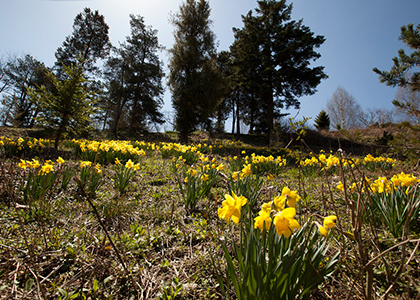
Since 2015, I’ve been working with the Dorena Genetic Resource Center, the USDA Forest Service’s regional service center for genetics in the Pacific Northwest, in Oregon. Part of the work at Dorena is to propagate tree seedlings that might have resistance to various diseases and pests.
As the conifer gardener at Cornell Botanic Gardens, I had two motivations—to contribute to the Forest Service’s efforts to help trees adapt to changing climate conditions, and to add species to our conifer collections.
The whitebark pine’s population is declining steadily due to several environmental and pest problems and this affects the entire ecological system around it. The tree co-evolved with the Clark’s nutcracker, a bird that creates huge caches of whitebark pine seeds. Bears will raid these caches for food. Because of its ecological importance, the species is under consideration for listing under the Endangered Species Act.
Dorena is one of the Forest Service units involved in research and replanting efforts to help save this important tree. Dorena and another Forest Service unit, the Coeur d’Alene Nursery in Idaho, donated whitebark pine (Pinus albicaulis) to Cornell Botanic Gardens to see if they might thrive in our Upstate New York climate.
This was has been a meaningful collaboration— we received new trees to add to our collection. Many of these grow on the east side of Conifer Slope, near the Nevin Welcome Center and just to the east of the Pounder Vegetable Garden. A woodchip path climbs up the slope and among the seedlings.
We continue to provide the Forest Service with data to add to its research. As a botanic garden at a research university, we have the resources to grow and monitor how whitebark pine seedlings perform in our environment, keep records on such data, and educate our visitors about organizations like the USFS and the important work it is doing.
In fact, we’ve expanded the collaboration to bring in seedlings of other species that are struggling in their native habitats. Gary Man, my initial contact at the Forest Service, put me in touch Richard Sniezko and Emily Boes at Dorena. They donated about 40 conifer seedlings, such as other species of pines and the Port Orford cedar (Chamaecyparis lawsoniana).
Sadly, several of the seedlings in this project died young, and that includes almost all of the whitebark pines. Many seedlings are doing well though, including the Port Orford Cedar and southwestern white pine (Pinus strobiformis) and limber pine (Pinus flexilis) from Coeur d’Alene.
I’m not sure why so many seedlings have failed, but the seedlings have been very small and I’m told they take some time to establish. It could be that our last few winters have just been too variable for them to survive in our outdoor nursery beds.
My gratitude goes out to our partners at the USFS for their donations, communications, and shared knowledge. We are continuing to work together to safeguard these important species in a changing climate.
Phil Syphrit is the horticulturist responsible for Cornell Botanic Gardens’ conifer collections